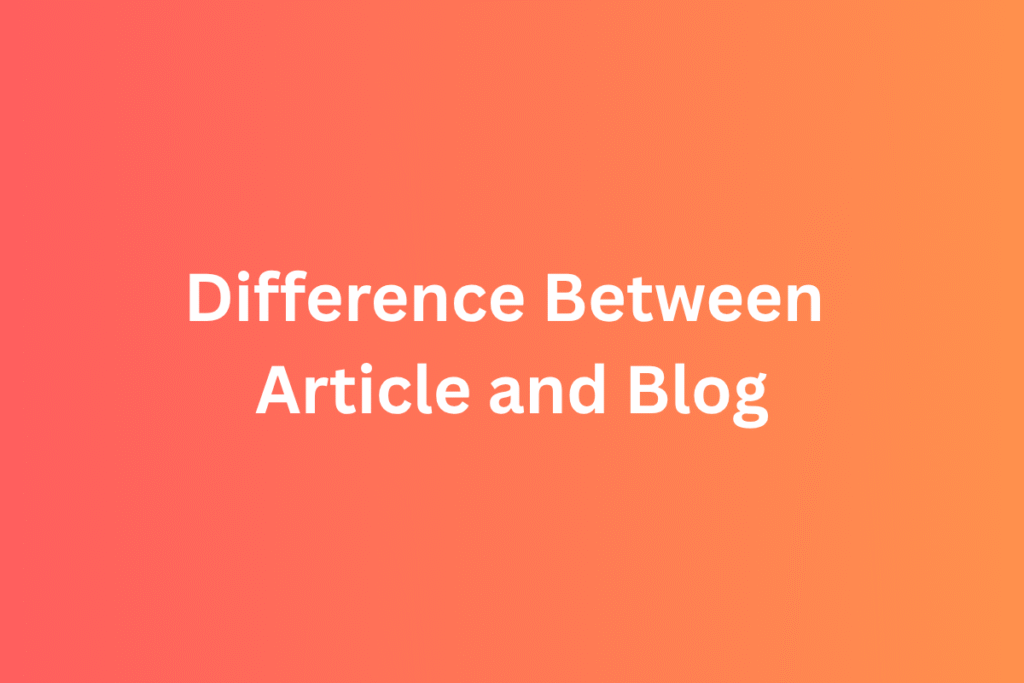If you’ve ever thought, “Can I really make money from blogging?”
Let me start with the truth: Yes, you can earn money writing a blog, but it doesn’t happen overnight. Gone are the days when you could throw a few words online and expect Adsense dollars to rain in.
Today, earning from a blog requires:
- Consistent content
- Deep audience understanding
- Smart monetization strategies
- Patience and long-term mindset
In this article, I’ll explain not just how bloggers make money but how you can realistically do it too, even if you’re just starting out.
Step 1: Understand How Blogs Actually Make Money
Before you think about monetization, you need to know where the money comes from. Bloggers earn through:
- Advertising – Display ads like Google AdSense or premium ad networks
- Affiliate Marketing – Promoting products/services and earning a commission on each sale
- Selling Digital Products – eBooks, courses, templates, printables
- Offering Services – Writing, coaching, consulting, design, etc.
- Sponsorships – Partnering with brands to write blog posts, reviews, or campaigns
- Subscriptions or Memberships – Paid content, exclusive communities
- Freelance Opportunities – Using your blog to get clients for writing or other skills
We’ll go through each of these in-depth in the sections below.
Step 2: Choose a Blog Niche That Can Be Monetized
This part is important. You might love writing about your life, your pets, or your travel memories and that’s great. But not all niches are equally profitable.
The best blog niches for making money usually sit at the intersection of:
- What you’re interested in
- What people are searching for
- What advertisers/brands are willing to pay for
Some Profitable Blog Niches Include:
- Personal finance (saving, investing, budgeting)
- Health & wellness (fitness, diet, mental health)
- Tech & gadgets (reviews, tutorials, comparisons)
- Career & skill development (writing, coding, freelancing)
- Travel (with affiliate links, bookings, etc.)
- Parenting, education, self-help
Don’t chase trends. Choose a niche where you can produce content for months without running out of ideas.
Step 3: Build a Blog That’s Content-First, Not Monetization-First
Here’s a mistake many beginners make they focus on money from day one, not quality. But the money only follows when:
- Your content solves a real problem
- Your writing builds trust and connection
- Your blog becomes a helpful destination for readers
Start by publishing at least 15–20 high-quality blog posts around your niche before worrying about ads or affiliate links.
Step 4: Grow Your Blog Traffic (Organic is Best for Long-Term)
No matter how good your content is, you won’t earn if no one reads it. Focus on organic (free) traffic first.
Proven Ways to Get Traffic to Your Blog:
- SEO – Learn basic keyword research, on-page SEO, and internal linking
- Pinterest – A great platform for blog traffic in niches like lifestyle, DIY, food, and travel
- Answering on Quora or Reddit – Link back to detailed blog posts where relevant
- Guest posting – Write for bigger blogs and link back to yours
- Social media – Use platforms like Twitter, LinkedIn, or Instagram to share your content
If you’re just starting, SEO will be your best long-term ally. It brings traffic even when you sleep.
Step 5: Monetization Methods (Deep Dive with Pros and Cons)
Let’s now explore each monetization method in detail with real-world examples and when to use them.
1. Google AdSense and Display Ads
What it is: You allow platforms like Google AdSense to show ads on your blog. You earn money when people see or click them.
Pros:
- Easy to set up
- Passive income once you have traffic
Cons:
- Requires high traffic (10K+ monthly views for decent earnings)
- Low-paying for some niches
When to use: After you’re consistently getting traffic. Later, you can switch to premium networks like Ezoic, Mediavine, or Raptive for higher CPMs.
2. Affiliate Marketing
What it is: You recommend a product or service using a unique link. When someone buys using your link, you earn a commission.
Examples:
- Amazon Associates (books, tools, electronics)
- Web hosting (Bluehost, Hostinger)
- Digital tools (Grammarly, Canva, Surfer SEO)
Pros:
- Can be very profitable
- Doesn’t require you to create your own product
Cons:
- Requires trust and well-written content
- Earnings depend on reader’s action
Pro Tip: Don’t force affiliate links. Use them in helpful tutorials, product comparisons, or “Top 10” lists.
3. Selling Digital Products
What it is: Creating and selling downloadable content: eBooks, guides, templates, or courses.
Example Products:
- A 30-day journaling challenge (for a mental health blog)
- SEO checklist for bloggers
- Short eBooks or poetry collections
Pros:
- 100% profit
- Scales well — sell once, earn forever
Cons:
- Requires effort to create
- Needs audience trust
When to use: Once you’ve built a small but loyal audience.
4. Freelance Services
Your blog can be your online resume. You write regularly in your niche, and clients notice.
Popular services:
- Blog writing
- Editing & proofreading
- SEO content
- Resume writing
- Copywriting
Pros:
- Quick way to earn without needing big traffic
- Clients find you through your niche writing
Cons:
- Requires active time and effort
- Not passive income
Pro Tip: Add a “Work With Me” page on your blog. Keep it simple — showcase what you offer, with links to your posts as samples.
5. Brand Sponsorships
Brands may pay you to review their product or write a blog post featuring them.
Example:
A fitness blog gets paid to write about a new protein brand or gym equipment.
Pros:
- High-paying once you have authority
- Long-term partnerships possible
Cons:
- Requires solid traffic or niche influence
- Not scalable for beginners
Start small. Even local brands might be willing to pay if your content matches their audience.
6. Newsletter or Membership Monetization
If you have loyal readers, offer them exclusive content.
Tools: Substack, Patreon, Ghost
Ideas:
- Behind-the-scenes writing
- Weekly writing prompts
- Paid courses or Zoom Q&As
Pros:
- Builds a community
- Recurring income
Cons:
- Requires consistent, premium content
- Takes time to grow a paying base
Step 6: Realistic Timeline to Start Earning from a Blog
Here’s what a realistic journey looks like:
- Month 1–3: Choose niche, write 10–15 blogs, learn SEO
- Month 4–6: Start getting traffic, join affiliate programs, build email list
- Month 7–9: First income from affiliate/small services
- Month 10–12: Launch digital product or apply for ad networks
- Month 12+: Scale traffic, earn consistent income (₹20K to ₹1L+ or $300–$2000/month)
Note: This depends on consistency. Blogging rewards those who stick with it.
The Blog is Just the Beginning
Writing a blog is not just about the money. It’s about building authority, creating value, and forming connections.
But yes you can absolutely earn money writing a blog if you do it the smart way. Pick a niche that works, provide real value, grow traffic patiently, and diversify how you monetize.
It’s like growing a tree. The early months feel slow. But one day, you’ll see it bloom and it will all be worth it.
Want help starting your blog or turning your content into income?
Reach out anytime I’d love to guide you step-by-step.




